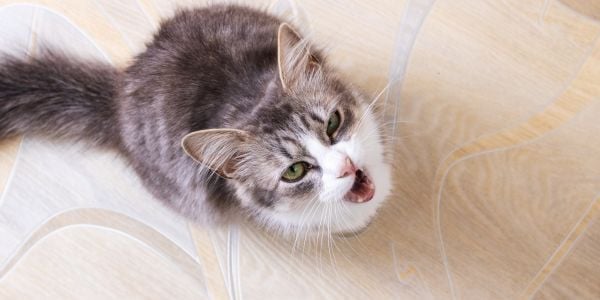 Some cats are talkers and have quite a lot to say each and every day. Personally, I love talkative cats because it gives me insight into how they’re doing.
Some cats are talkers and have quite a lot to say each and every day. Personally, I love talkative cats because it gives me insight into how they’re doing.
Other cats only meow every now and then, cluing you in when something changes, or they have a need to be met.
A yowl, on the other hand, is a loud, wailing meow that is not typical of a cat’s everyday meow. It’s designed to grab the attention of another cat or person and can indicate that the cat is emotionally or physically distressed.
A cat may also tell us something is upsetting them by meowing much more than usual.
Why a Cat May Yowl or Meow Persistently
Sometimes, a lot of talk from your cat is just fine. Other times, they may be trying to get something from you, like attention or food. But there are times that it can indicate a problem. If your cat’s vocal habits suddenly change, whether they're meowing or yowling, that’s when it’s really time to pay attention.
Let's take a look at different vocalizations and show you how to address them.
General Vocalizing in Cats
This type of vocalization is generally not of concern, but your cat wants or needs something from you.
Normally talkative cats
Some cats are vocal by nature, like Siamese. These cats may tell you quite a bit about their daily lives. Others learn that being vocal gets them what they need, like your attention or a treat. This level of vocalizing may be normal for these cats as long as they are playful, happy, eating well, and do not show any signs of distress such as weight loss, soiling outside of the litter box, signs of estrus (heat) despite a spay, hiding, or aggression.
Let’s play!
Meowing may be your cat’s way of grabbing your attention. Set aside at least 10–20 minutes twice a day for cat playtime with a wand toy and chasing sessions with their favorite toy. Learn how to play using the prey sequence, which mimics hunting.
If your cat is harness-trained, this is a good time for an outdoor walk. Make sure your cat has this private time with you each day to prevent boredom and to keep your cat exercised.
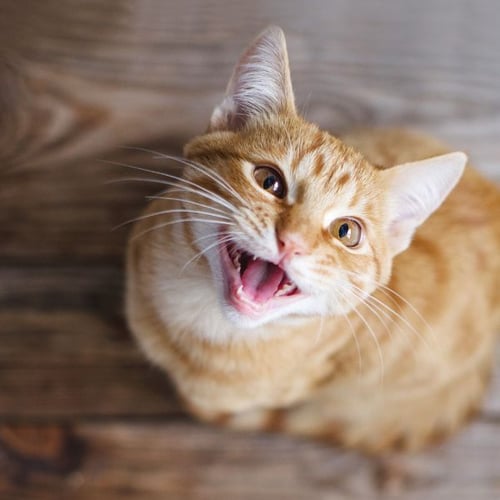
I'm hungry!
This may be a “I am hungry!” notification before mealtime or an unwelcome "hangry" cry if it begins when you're asleep. If your cat regularly vocalizes for food and it’s a problem for you, first make sure they’re getting enough daily calories by talking with your veterinarian. Then do a little training.
Instead of feeding your cat while they’re vocalizing, which teaches them to be vocal to get what they need, wait for them to take a natural break. When they’ve stopped for a couple of minutes it’s OK to feed them. They won’t make the association between vocalizing and getting fed.
If it’s happening overnight or too early in the morning, check out our article on how to stop your cat from waking you up.
If your cat suddenly seems hungrier and more obsessed with food, it is time for a vet visit to ensure there is no medical reason behind their increased appetite. Certain conditions such as hyperthyroidism, diabetes mellitus, and acromegaly can cause an increased appetite.
*An Important Note About Meals. Cats must eat more than twice a day. They have very small stomachs that can’t hold much food. They will start to get hungry after about 5 hours. Most cats need access to food around every 8 hours. If your cat is going without food for more than 8 hours, that may be the reason for their vocalizing. They’re legitimately hungry.
Anxiety, Stress, and Fear
Cats are very sensitive creatures, and many things can cause them stress or fear. When your cat is stressed, they may become more vocal.
Triggers for Stress and Fears in Cats
It’s common for cats to be nervous or uncomfortable with things they don’t know or think can do harm. With some advance planning, we can prevent some of that stress, and we can also treat the stress if it has already started.
Examples of cat stressors
-
Car rides
-
Veterinary visits (check out our tips on how to make these less stressful)
-
New cat or dog (read how to introduce cats and dogs)
-
New baby
-
Visitors to the home
-
Renovations
-
Moving to a new home
-
Fighting between cats in the household (read this true story and the tips that helped these feuding feline siblings)
-
Stranger cats outside (if your cat is spraying indoors inappropriately, it could be because of an outdoor cat; see tips to help you and your cat)
If your cat is stressed or anxious, you may see some of these signs:
-
Decreased activity with family members
-
Decreased appetite
-
Decreased activity level
-
Peeing and/or pooping outside the litter box
-
Hiding
-
Trembling
-
Yowling or excessive meowing
-
Aggression
-
Changes in their normal behavior and habits
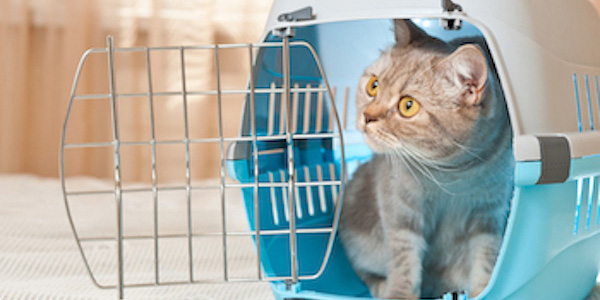
Stress desensitization
If you know there’s something coming up soon that is likely to stress your cat, do some desensitization ahead of time. Use a slow process of exposing them to the stressor at a very low intensity, gradually turning up the intensity, and pairing each step with something they love, like treats and verbal praise. Let’s use going in their carrier as an example.
-
Start at a point where your cat has no reaction to the scary thing — in this case, the carrier. That may be your cat standing a couple of feet away from it. Open all the doors to the carrier.
-
Toss a treat near the carrier to a spot where your cat is comfortable eating it.
-
Continue tossing treats, getting your cat closer to the carrier with each toss.
-
Then move on to setting a treat on the edge of the carrier entry. If your cat eats it, set the next treat just inside the entry. Continue moving each treat farther back into the carrier until your cat is fully inside.
-
Now, give your cat a treat and then close one door for just a second before opening it back up. It should be quick enough that your cat doesn't even have time to think, "Uh oh, the door closed." Remember, never push part their comfort zone.
-
Give another treat and hold the door closed for a couple of seconds before opening it up.
-
The idea is that you continue to increase the intensity by closing the doors for short periods, then longer, until your cat is fine being in the carrier with all doors closed for a minute or two. From there, you can continue the process as far as you’d like. Increase the length of time slowly. Then pick the carrier up. Gradually move on to carrying it around the home. Then gradually move to opening the front door, walking outside, opening the car door, putting your cat in the car, starting the car, taking a short drive, and so on.
-
Each step in the right direction means your cat gets a treat or something they love.
If your cat shows even tiny signs of stress or hesitation at any step, that just means slow down. They’re not ready for that step yet. Back it up and move a bit more slowly.
This same process works for anything that makes a cat uncomfortable. Just find that low-intensity starting point and gradually work your way to full intensity.
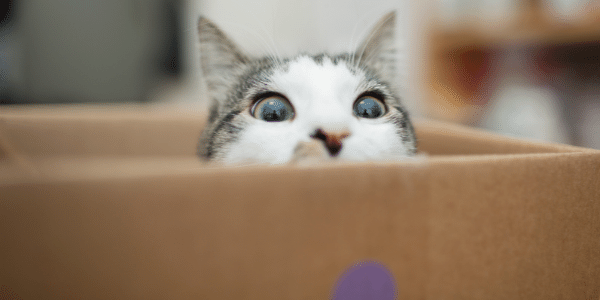
General Stress
If your cat has general stress or anxiety that’s causing vocalizing, you can help reduce it. Try some of these tips:
-
Try to remove any known stressors if possible.
-
Use lots of play and mental enrichment to reduce stress and build confidence.
-
Pair stressful things like loud sounds or guests with things your cat loves, like treats, pets, and play.
-
Reward your cat for brave behavior, like coming out after hiding or not hiding when startled.
-
Use a feline pheromone diffuser in areas where your cat spends the most time.
-
Consider calming supplements such as alpha-casozepine and/or L-theanine.
-
For more extreme cases, talk with your veterinarian about anxiety medication and/or work with a certified feline training and behavior specialist to address the anxiety.
If your cat shows signs of persistent stress or if they suddenly become stressed, contact your veterinarian because an examination may be necessary to rule out a medical issue.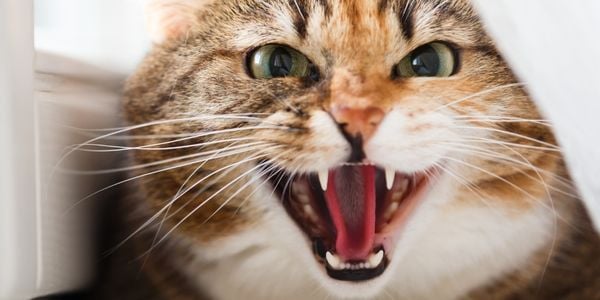
Aggression and Fear
Yowling and other vocalizing can often come with aggression. And aggression most often comes from fear. So, this yowl can be quite loud and is meant to scare a potential threat, whether that’s another cat in the household, a neighborhood cat outside, a very loud sound, or even a person.
This type of vocalizing won’t be a regular occurrence. It’s reserved for serious situations. Learn more about aggression and cat body language.
Signs a cat may become aggressive (cats may not have all signs at once):
-
Yowling
-
Growling or hissing
-
Dilated Pupils
-
Hiding or trying to look small
-
Swatting
-
Staring intently or stalking
-
Hair standing on end or trying to look large
-
Raised back with a curved tail
-
Ears turned to the side or back
Feline aggression is complicated. But there’s a lot you can do to help your cat through it. Learn more about the different types of aggression and how to manage them.
Mating Hormones and How It Affects Cats
Any cat, whether they’re intact, spayed, or neutered, who has had exposure to increased levels of estrogen may show signs of yowling, increased meowing, increased affection, or aggression.
Causes of high levels of estrogen include:
Estrus or a heat cycle: A female cat sends out a very loud yowl, often called a caterwaul, as she searches for a mate during her estrus or heat cycle, which lasts an average of 7 days. Female cats can have their first heat at about 5 months of age. If she does not become pregnant, she can return to heat in 2–19 days. These cycles stop once a cat is spayed. The American Association of Feline Practitioners recommends that cats be spayed by the age of 5 months to prevent unwanted kittens and offer protection from mammary cancer, pyometra (infection of the uterus), and behavior issues. Read more about the benefits of spay/neuter.
Note: Male cats will yowl in response to the female caterwaul!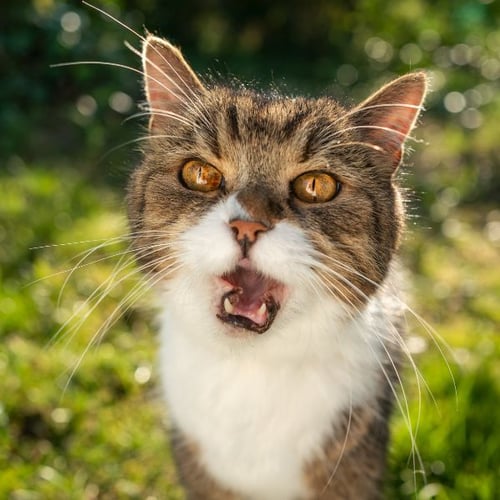
Ovarian Remnant Syndrome in spayed female cats: During a spay (ovariohysterectomy), all of the ovary is removed. However, in rare instances, some ovarian tissue can be left behind, causing a female cat to show signs of estrus (heat) months to years later.
Diagnosis of Ovarian Remnant Syndrome can be difficult because the ovarian tissue left behind (ovarian remnant) is typically very small.
Your veterinarian may look at:
-
Blood tests, including measuring Luteinizing Hormone and Progesterone.
-
An abdominal ultrasound is sometimes able to find a remnant when a cat is in estrus (heat).
-
Anti-Mullerian Hormone test to determine if ovarian tissue is present.
-
Exploratory surgery to find and remove an ovarian remnant during a heat cycle. This is the most reliable method of diagnosis and treatment.
Exposure to estrogen medications: Examples include veterinary medications diethylstilbestrol (DES), estradiol cypionate, or human transdermal estrogen products. In addition to the behavioral signs, toxic levels of exposure from medications can cause bone marrow suppression with anemia, blood loss, and immune suppression.
An immediate veterinary visit is essential if there is any suspicion that a cat has licked or eaten a medication containing estrogen. When in doubt, reach out to a pet poison hotline for advice.
Medical Causes for Yowling or Excessive Meowing
There are a number of medical issues that can cause your cat to vocalize. Again, a sudden increase in vocalizing means it’s time for a vet visit. But there are also long-term conditions that can cause a cat to be more vocal at times.
Pain
Cats are masters at hiding pain. Some cats will tell us that something is wrong with a yowl or persistent meowing, as well as other changes to their normal behavior and routines. If your cat is showing any unusual behaviors, take a video to share with your veterinarian, as this can be very helpful. NEVER give your cat pain medication, especially human pain medication, without advice from a veterinarian. You could harm or kill your cat.
Signs of pain in cats:
-
Persistent or unusual meowing
-
Hiding, interacting less with family members
-
Reluctant to jump up and down (for example, counter, bed, windowsill)
-
No longer going up the stairs or hesitant to do so
-
Having trouble getting into or out of the litter box
-
Soiling outside the litter box
-
Sleeping more
-
Playing less
-
Grooming less or excessive grooming in a certain spot
-
Sensitive to being touched in certain areas
There are many causes of pain, such as infection, dental disease, arthritis, urinary issues, eye inflammation, and cancer. If you think your cat may be in pain, please visit your veterinarian for a diagnosis so that your cat can start to feel better. Often, once they're showing the signs of pain, they are suffering greatly.
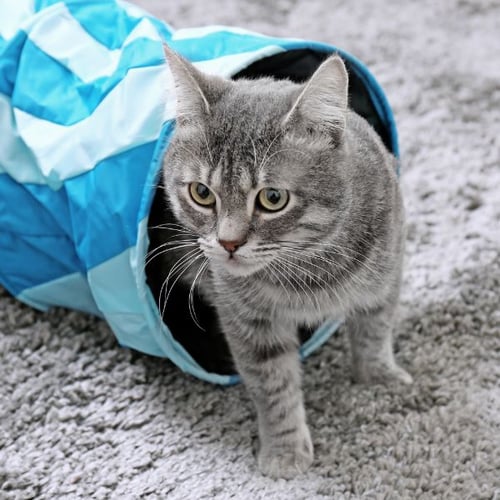
Hyperthyroidism (Overactive Thyroid)
Hyperthyroidism causes the metabolic rate in cats to increase. Imagine you have had several cups of coffee, and your heart is racing. Along with that “wired” feeling, cats get very hungry because their metabolic rate is set to “GO” all the time.
Most cats tend to eat more, yet they lose weight over time. A common symptom in cats with hyperthyroidism is excessive meowing or yowling. Many pet parents worry that their cats are hungry because they are losing weight. Yet, offering more food does not always relieve the meowing of a hyperthyroid cat.
Symptoms and clinical signs of hyperthyroidism include:
-
Weight loss despite a normal to increased appetite
-
Behavior changes such as increased activity, agitation, excessive meowing
-
Vomiting, diarrhea
-
Increased drinking, increased urination
-
Poor grooming
-
Fast breathing or panting
-
Enlarged thyroid gland
-
Heart murmur
-
High blood pressure
-
Retinal changes in the eye
Diagnosis of hyperthyroidism is a blood test – the Total T4 and/or the Free T4. Occasionally, especially in cats with other systemic diseases, a confirmatory test may be performed, such as a nuclear thyroid scan. Treatment options include medication, diet, surgery to remove the thyroid gland or non-invasive radioactive iodine (I131) treatment.
Hypertension (High Blood Pressure)
High blood pressure is very sneaky, causing damage to the brain, eyes, kidneys, and heart without showing any outward signs.
15–46% of cats with high blood pressure may have neurologic or behavioral signs such as:
-
Lethargy, stupor
-
Head tilt
-
Difficulty walking
-
Disorientation
-
Excessive meowing
-
Sensitivity to light
-
Tremors
-
Collapse
-
Blindness
Many of these symptoms are reversible with quick treatment at a veterinary hospital. This includes treatment to reduce the blood pressure and treatment of any underlying condition. The most common underlying conditions include kidney disease and hyperthyroidism in cats.
Cognitive Dysfunction Syndrome (CDS)
As cats get older, they may develop Cognitive Dysfunction Syndrome, which is similar to dementia in human beings. The signs can be difficult to differentiate from some medical issues, so keeping a log of anything out of the ordinary and taking videos of changes in your cat’s behavior will really help your vet with a diagnosis.
Signs of cognitive dysfunction in cats:
-
Persistent meowing or yowling
-
Disorientation
-
Changes in sleep habits, such as being awake when the cat would usually be asleep
-
Behavior changes, such as becoming anxious, more affectionate, or more detached
-
Repetitive movements, such as pacing or circling
Cognitive Dysfunction Syndrome is diagnosed when all other medical possibilities have been ruled out. There are no specific therapies for this illness. However, there are treatments such as Omega-3 fatty acids, SAMe, and prescription medications that may be helpful. Enrichment activities in the early stages, such as treat puzzles and interactive games, may delay progression.
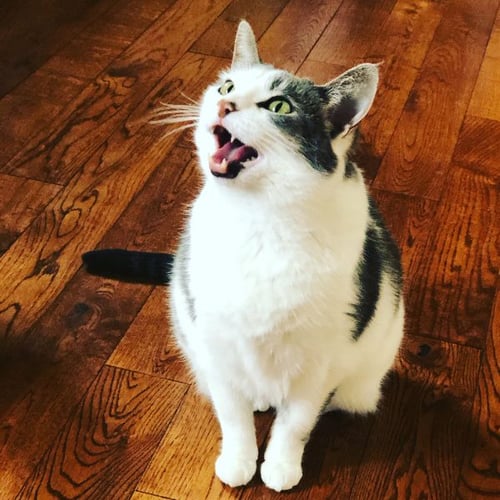
At times, it may drive you a little crazy. But it's actually a good thing that your cat is talking. They're not trying to bug you or stress you out. They're looking for a way to communicate that you will respond to. You are your cat’s advocate. Listen to what your cat is trying to tell you, and hopefully, you will understand each other better.
If you have any questions for us, please leave them in the comments below, and we'll answer them. We're listening!



